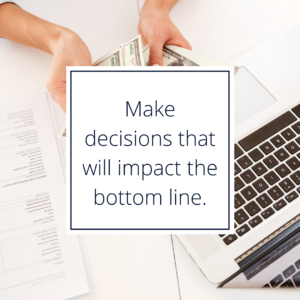Reading Your Profit & Loss Statements

Business owners know that Profit & Loss (P&L) Statements are the most common financial statement in any business plan. This is because the P&L financial statement is what bankers and investors will flip to first when reviewing your business plan. Reason being, the P&L tells you and other interested parties if your company is profitable or not. Dig in a little deeper to gain more of an understanding when reading your profit and loss statement.
How to make decisions that will impact the bottom line.
Profit and Loss Statements typically summarize your revenue, costs and expenses, and the important “bottom line” (or your net profit). One of the fastest ways to determine if your business’ bottom line is in the red or in the black is to simply flip to your P&L and look at the bottom results.
As you scan your P&L statement, you will see the revenue you are bringing in from sales. Obviously, the more income you have, the more you can allot to expenses needed to run operationally. However, a smaller incoming of cash flow can prompt a need to slim down spending.

Every company wants to make money, but saving funds also helps you greatly in being profitable. Clearly, if you’re making more than you’re spending, you’re able to stay in the black. By reading your P&L, you can quickly assess what your company is paying for direct costs of goods and services (COGS), and if it supports the outgoing expenses.
This leaves a gross margin. Which is the difference between what you’re making and what you’re spending. Basically and simply put, your revenue, minus expenses equals your gross margin. When you see a high gross margin on your P&L statement, you can discern that it costs you very little to deliver your product or service. This means you’ll have the majority of the money from every sale left over to cover your expenses.
Likewise, a lower gross margin means there is less profit to collect between your costs of production and your actual sales. Knowing this will help you make decisions that will impact your bottom line.
We specialize in reading and consulting around P&L statements. Our experience can help you make decisions or learn of different approaches to spending and saving that can help your business’ budget and goals.
How do you know something is wrong with your business finances?
Negative balances.
Reading your P&L statement is going to help you quickly determine if something is wrong or awry in your cash flow. Firstly, and perhaps most glaringly, if your P&L is showing a negative balance, things are definitely alarming. A solid bookkeeper will never let your account go below zero. And even then, it could be because checks are pending being cashed. Still, a negative balance is exactly that. A negative needing correction.
An unbalanced balance sheet.
Aptly named the balance sheet, your assets must equal or balance your liabilities plus net worth. If your balance sheet doesn’t balance, someone has entered the inaccurate information.
Inventory values remain the same month-after-month.
Another obvious issue with your P&L could be eerily consistent inventory values for months at a time. If your value is exactly $45,000 and has stayed at that value for months, chances are your staff or bookkeeper is guessing at your value or hasn’t intentionally tracked inventory changes down to the cent each month. This is a no-no and a sign you should hire a bookkeeper that has your bottom line as their top priority. Reading your profit and loss statement is a task that must be done regularly and mindfully – either by your a hired professional.
Taxes are off.
Are you actually getting a tax return from the government? That doesn’t sound right. But, that is exactly what a negative tax payable balance implies. Either someone in your accounting department has failed to follow proper protocol or payroll taxes are late. If you want to stay out of the red, make sure you see these red flags ahead of time.
Reading Your Profit & Loss Statements Answers “Am I profitable”?
There are a few ways to quickly glance at your P&L statement to determine if your business is profitable. We recommend the following line items to look at for clarity on cash flow.
Check your Net profit margin.
This key number determines your company’s profitability. Use this simple formula to calculate net profit: Revenue – Expenses = Profit. A positive number means you’re turning a profit. If it’s a negative number, your business is losing money. Zero means you’re breaking even. For example, a business with revenue of $125,000 per year and $15,000 in expenses has a net annual profit of $110,000.
Visit your Operating Expenses.
If your revenue is increasing but you’re noticing your profit decreasing, you’ll want to check your operating expenses. It could be that expenses are increasing faster than your revenue is.
Turn to your P&L statement in a category likely named “total expenses.” A reputable bookkeeper or accountant will bounce monthly expenses off of monthly revenue to find any patterns or inconsistencies. If and when a steady increase or even overly excessive amount is viewed, your bookkeeper should start to immediately offer suggestions for reducing costs.
Hire a Bookkeeper you can trust is reading your profit and loss statements with the intention to help your business grow.
You don’t just want to hire someone to do the numbers. You want them to work with the numbers in a way that seeks long-term growth! For us at Two Sense Consulting, we enjoy getting lost in a good P&L statement with the intention of finding our way out with successful solutions for you as a business owner and your bottom line.







